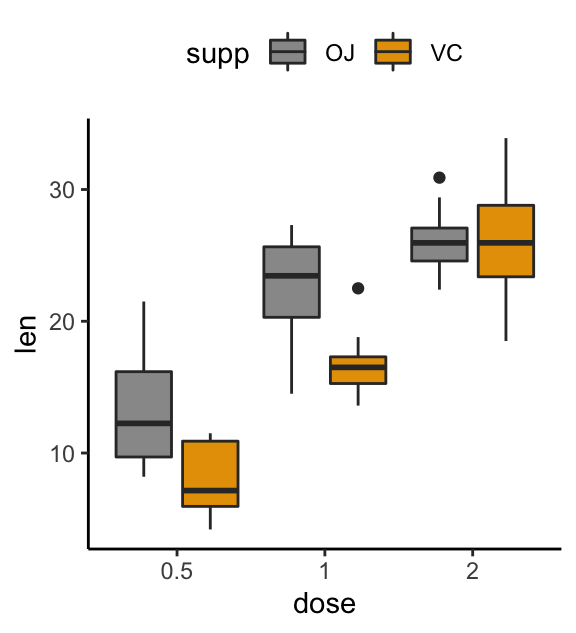

Grp3 <- tibble(value = rep(seq(0, 20, length.out = 5), 5),Īre there underlying patterns in the data? Ggplot(data, aes(x = group, y = value)) +Įxpand to generate same sample data. Why? Let’s plot some box-and-whisker plots: They also have a high potential of misleading your audience-and yourself. But in my opinion they are not always helpful 1. Box plots are great! Box plots are an artwork combining many summary statistics into one chart type. And before that impression settles, that’s not correct.

Thanks to my “Evolution of a ggplot” blogpost, I am already known as someone who is not a fan of box plots. # overwrite other defaults of theme_minimal() # set custom font family for all text elements
#Boxplot ggplot2 by group install#
# install gghalves from GitHub if neededĭevtools::install_github('erocoar/gghalves') If(length(new_pckgs)) install.packages(new_pckgs) Pckgs <- c("ggplot2", "dplyr", "systemfonts", "ggforce", In January 2021, a revised version was submitted together with a “fully functional R-package” called. The paper itself that introduces raincloud plots comes with a “multi-platform tool for robust data visualization” which consists of a collection of codes and tutorials to draw raincloud plots in R, Python, or Matlab. Some examples for which I used raincloud or violin plots to explicitly highlight the distributions of the values.
#Boxplot ggplot2 by group code#
I always cover the topic in detail during my workshops and sometimes even specific sessions on the topic and I have regularly used raincloud plots for various occasions: during my PhD to show that the model fitting was appropriate across simulations ( code), as contribution to the #SWDchallenge to illustrate differences in temperatures in Berlin across months ( code), or as contribution to #TidyTuesday to visualize the distribution of bill ratios in brush–tailed penguins ( code and code): The use of other chart types such as violin and raincloud plots to show the distribution or even the raw data is a topic I am since years pretty passionate about. Here is a fun meme I made a few months ago when I encountered so–called “dynamite plots” in a paper I was reviewing (plus here is a reworked version with Shrek instead): And in contrast to the reviewer above, I argue completely opposite and always share my concerns in case bar charts or box plots are not suited to convey the study results. Since I am still working (part–time) as a researcher, I also regularly review scientific articles myself. Instead, raincloud plots combine several chart types to visualize the raw data, the distribution of the data as density, and key summary statistics at the same time. Raincloud plots were presented in 2019 as an approach to overcome issues of hiding the true data distribution when plotting bars with errorbars-also known as dynamite plots or barbarplots-or box plots. A suitable chart hybrid, consisting of a combination of box plots, violin plots, and jittered points, is called a raincloud plot. Quickly, people settled that (a) violin plots are not novel at all but were introduced 23 years ago and (b) providing an overview of the summary statistics and even the raw data itself might be a good addition. Note: Due to the recent changes on X (formerly known as Twitter) I have replaced the embedded tweets with static images. A few weeks ago, I came across this tweet:


 0 kommentar(er)
0 kommentar(er)
